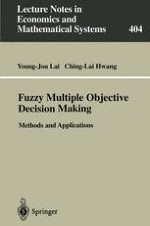1994 | OriginalPaper | Chapter
Fuzzy Multiple Objective Decision Making
Authors : Prof. Young-Jou Lai, Prof. Ching-Lai Hwang
Published in: Fuzzy Multiple Objective Decision Making
Publisher: Springer Berlin Heidelberg
Included in: Professional Book Archive
Activate our intelligent search to find suitable subject content or patents.
Select sections of text to find matching patents with Artificial Intelligence. powered by
Select sections of text to find additional relevant content using AI-assisted search. powered by
In the previous chapter, we have discussed a variety of computationally efficient approaches for solving crisp multiple objective decision making problems. However, the input data, such as the unit profit/cost, goals, available resources and/or technological coefficients, may not be precisely determined because of incomplete or non-obtainable information. For instance, the unit profit and cost (C) of new products may be expected to be “near $2.3” and “above $7.5.” Available labor hours and available material (b) may be “around 1220” hours and “about 1550” units, respectively, and the estimates of technological coefficients (A) may be “around 3” units per labor hour. In this chapter, we use preference-based membership functions, μ(·), to resolve this fuzzy nature and obtain fuzzy multiple objective decision making problems (FMODM). FMODM problems are then transferred into crisp auxiliary MODM problems which can be solved by techniques discussed in Chapter 2 or by any prevailing MODM methodologies. If the imprecise nature of input data is modelled by possibility distributions, π(·), of possibility theory, then we would have possibilistic multiple objective decision making (PMODM) problems, which will be discussed in the following chapter.
